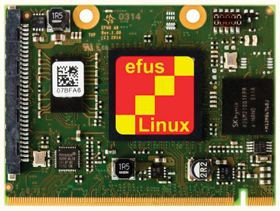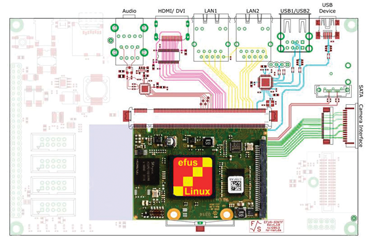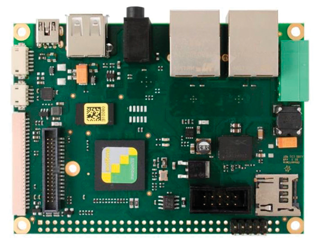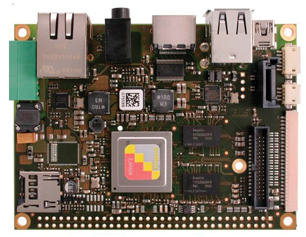Zoltán Kiss- Area Sales Manager - East Europe - Endrich GmbH.
Embedded modules and COM boards from F&S Elektronik Systeme
3 October 2014

Summary :
Embedded SystemOnModule (SOM) solutions provide simplicity and faster time to market for the end product, rather than designing custom made solution for a certain task. Embedded modules, like COM (computeronmodule) are categorized as a subtype of Single Board computers (SBC), they are more than just the microcontroller, but less than a fully equipped personal computer. Today the COM boards are usually built on a single board, and offer a compact computer system for custom applications, that require low power consumption and small physical size as it is expected by embedded systems.
COM boards and Single Board Computers
The COM boards are based on a microprocessor with memory (RAM), I/O controllers all features required by a computer, but unlike a single-board computer, the COM will usually miss the standard peripheral connectors. Some of the COM modules are to be mounted on a carrier board, which offers the physical porting to standard peripheral connectors. Some COMs also include peripheral connectors and/or can be used without a carrier. Being able to choose an available carrier board could be a benefit by means of less design work if implementing usual I/O interfaces, memory devices and connectors is enough. On the other hand using an own designed carrier board provides higher customization possibilities, as designer can keep customized functions on the carrier board. Anyway, separating the design of the carrier board and COM makes design concepts more modular, as the core components and functions are located on a COM, which is easy to upgrade by replacing, when a next generation CPU should be implemented. Without having to redesign a very specialized carrier, the upgrade could be done in a cost saving way, as well as it is possible to shorten development times. Of course the boardto- board connection between the upgraded COM and its carrier should be compatible with the original version.
F&S Elektronik Systeme – leading provider of embedded solutions
The German company F&S Elektronik Systeme is an ISO9001 certified developer and producer of ARM-based embedded modules. Every module is shipped with a running operating system. For every board there is the choice between Windows (WCE 6.0/WEC 7/WEC 2013) or Linux.
EFUS COM module

EFUS brand name of F&S stands for Easy, Functional, Universal and Small (47x62.1x11 mm), which characterize this COM board. The module can be fixed to the baseboard by simple click, and the unit is ready to resist up to 50G shock, ideally usable in vibrating surrounding. The new standard layout guarantees a low cost carrier board by describing the concept of no crossing lines and through holes. The schematic data for developing a base board under EAGLE is available. Further feature is the opportunity to expand the COM with wireless chip on modules, like WLAN (with chip antenna) or ZigBee, by the pre-designed extension points there is no need to change the layout of the CPU area for an expansion, just adjust the software drivers.

The CPU being used on this COM bard is the FreeScale’s i.MX6 Cortex-A9, that also features excellent 3D multimedia graphics, hardware encoder/decoder with a resolution up to 1 080p. The ARM Cortex A9 CPU is known about its low power consumption (0.35mW/MHz), when using it, there is a right compromise between performance (MHz) and necessary energy. Further advantages are the long time availability (1 5 years) and the wide temperature range of -40 ºC ± 85 ºC. The interfaces provided by this COM module are among others the Ethernet LAN interface, serial, USB, CAN, I2C, SPI, SDCard, SATA, PCIe and camera interfaces. EfusA9 makes it possible to control an RGB display, an LVDS display and a DVI device simultaneously. It supports up to 1GB DDR3 RAM as well as up to 1GB Flash + 32 GB eMMC program memories. Linux, WEC 7 as well as Windows Compact 201 3 are available as operating system.

armStone™single board computer
For the COM board based technical solutions that require a carrier board, the integrated Single Board computer can be an alternative, where no need to develop a carrier board as the SBC contains all necessary interfaces and connectors to the outside World. By this way the development costs and the time to market can be minimized. A popular product range of this kind is the armStone™ Single Board Computer family at F&S, which offers all common interfaces (via standard connectors or multi-pin connector). A primary display can be connected via a LVDS interface while a further display interface (DVI) is available. The PicoITX form factor with its a size of 1 00 x 72 mm perfectly fits for compact, but powerful – even portable – applications. ArmStone™ is powered by Single Supply of 5V. Depending on the chosen CPU, the power consumption can only be as low as a few Watts, making it possible to use he device without fan or huge cooling element. The armStone™ is shipped with a pre-installed operating system. At present, WCE 6.0/ R3, WEC 7/201 3 (including Microsoft license) and Linux are available. The heart of the armStone™A5 is the Freescale Dual-Core CPU (Asymmetric Multiprocessing). The Vybrid CPU is suitable for industrial environments and is long-term available (1 0 years and more). It owns two cores: Cortex-A5 – 500MHz and Cortex-M4 – 1 67MHz. Functions such as 2D acceleration and Window-Layer, FPU, as well as NEON are also available. The armStone™A5 can be equipped with up to 51 2Mbyte DRAM and up to 1GByte Flash, but 1 28Mbyte NAND Flash are already enough to boot a complete Windows Embedded CE or Linux directly from Flash. The board offers interfaces like USB Host/Device, 2x LAN, 3x RS232, 2x CAN, SPI, I²C, Audio (IN/ OUT/ MIC). The board can be upgraded with micro- SD cards an option. For the display functions, there is the LVDS interface available (max. resolution up to XGA) or as an alternative, a RGB interface up to SVGA. Touch panel interfaces for resistive and also capacitive touch are offered as well. The armStone™A9 runs on the Freescale i.MX6 Quad-Core ARM Cortex-A9 CPU (NEON, FPU, OpenGL/ ES 2.x, 3D, MPEG4). The highlight of this CPU is its long availability for more than 1 5 years (Freescale Product Longevity Program). The armStone™A9 is equipped with up to 4GByte DDR3 SDRAM, some GByte Flash and Gigabit Ethernet. Further interfaces are 4x USB 2.0 Host, USB 2.0 Device, CAN, I²C, SPI, Audio, SDIO, PCIe and serial interfaces. For display control, 2-channel LVDS (up to WUXGA -1 920 x 1 200), RGB (up to SVGA) and HDMI/ DVI (up to HD1 080) are available simultaneously (with different content also). For the connection of a touch panel (resistive and capacitive), the touch controller board with I²C can be used. A supply voltage of 5V (8-1 4V) results a power consumption of about 3W, so the armStone™A9 can be applied without a fan or cooling device; allowing a highend computer graphic at extremely low power loss. Especially for multimedia, additional hardware units are available in i.MX6 (OpenGL/ ES 2.x, 3D with OpenCL, OpenVG 1 .1 ), relieving the CPU significantly, and having a positive effect on fluid displaying and low power consumption.
Design strategy
Using the above detailed boards, in case of changed requirement for higher processor power or more interfaces comes up, there is a possible solution, as every board family by F&S Elektronik Systeme offers pin and software compatible items. More boards are introduced annually and are added to the board family or replace faced out boards (after 1 0 years). With this board strategy, the customer takes no risk at all.

| armStoneA5 | armStoneA9 | armStoneA9r2 | ||
| Processing power | ++ | ++++ | ++++ | |
| CPU | Typ | Freescale Vybrid | Freescale i.MX 6 | Freescale i.MX 6 |
| No. of cores | Single / Dual-Core | Solo / Dual / Quad-Core | Single / DualLite / QuadPlus | |
| Cores | ARM Cortex-A5 & -M4 (max. 500 & 167 MHz) | ARM Cortex-A9 (max. 1.2 GHz) | ARM Cortex-A9 (max. 1 GHz) | |
| GPU | NEON | 3D, 2D, Open VG, Open GL | 3D, 2D, Open VG, Open GL | |
| Windows/Linux | WCE 6.0, WEC 7, WEC 2013 / Linux | WEC 7, WEC 2013 / Linux | WEC 2013 / Linux | |
| Flash (max) | 1 GB* | 1 GB* | 1 GB SLC + 32 GB eMMC* | |
| RAM (max) | 512 MB | 4 GB | 4 GB | |
| µSD Card | 1x on-board | 1x on-board | 1x on-board | |
| Ethernet | 2 x 10 / 100 Mb | 1x 10 / 100 / 1000 Mb | 1x 10 / 100 / 1000 Mb | |
| USB Host / Device | 1-2x / 1x | 4x / 1x | 4x / 1x | |
| CAN / UART | 1-2x / 3x | 1x / 3x | 2x / 5x | |
| I˛C / SPI | 1-2x / 1x | 1x / 1x | 1x / 2x | |
| Audio | Line In / Out / Mic | Line In / Out / Mic | Line In / Out / Mic | |
| Touch Panel | 4-wire analog resistive PCAP-Touch via I˛C |
4-wire analog resistive PCAP-Touch via I˛C |
4-wire analog resistive PCAP-Touch via I˛C |
|
| SATA / PCIe | 1x / 1x | 1x / 1x | ||
| RGB/LVDS | 18 bit / 18 bit | 18 bit / 2x 18/24 bit | - / 2x 18/24 bit | |
| Temperature range | 0°C ... +70°C [-25°C ... +85°C]* | 0°C ... +70°C [-25°C ... +85°C]* | 0°C ... +70°C [-25°C ... +85°C]* | |
| Specials | Camera digital, WLAN, Bluetooth | |||
| Minimal availability | 2023 | 2029 | 2029 | |
| Share on Facebook | Share on LinkedIn |
References
This article has been published on the following locations:
| # | Media | Link |
|---|---|---|
| 1 | Elektronet 2014/6 | Elektronet : elektronikai informatikai szakfolyóirat, 2014. (33. évf.) 6. sz. 30-32. old. |
| 2 | Elektronet online | F&S beágyazott modulok és COM-kártyák az Endrich kínálatában |
| 3 | Hungarian version | F&S beágyazott modulok és Com kártyák |


